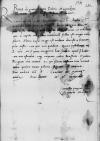Letter #1756
Bona Sforza to Ioannes DANTISCUSCracow (Kraków), 1537-10-28
| received [1537]-11-11 Manuscript sources:
Auxiliary sources:
Prints:
| ||||||||||||
Text & apparatus & commentaryPlain textText & commentaryText & apparatus
Reverendo
in Christo Patri, Domino
Reverende in Christo Pater, sincere nobis dilecte.
Attulit et reddidit nobis
Quare postulamus a Paternitate Vestra, ut si quam imaginem huic similem apud se habet, eam non ostendat neque cuiquam extra
Bene valeat Vestra Paternitas.
Commissio propria

